The background
Question edited heavily for clarity
I have data like this:
df<-structure(list(fname = c("Linda", "Bob"), employee_number = c("00000123456",
"654321"), Calendar = c(0, 0), Protocol = c(0, 0), Subject = c(0,
0), CRA = c(0, 0), Regulatory = c(1, 1), Finance = c(0, 1), ResearchNurse = c(0,
0)), row.names = c(NA, -2L), class = c("tbl_df", "tbl", "data.frame"
))
In a previous question I asked on here, I mentioned that I needed to pivot this data from wide to long in order to export it elsewhere. Answers worked great!
Problem is, I discovered that some of the people in my dataset didn't fill out their surveys correctly and have all zero's in certain problematic columns. I.e. when they get pivoted and filtered to "1" values, they get dropped.
Luckily (depending on how you think about it) I can fix their mistakes. If they left those columns blank, I can populate what they should have based on their other columns. I.e. what they filled out under "CRA","Regulatory", "Finance" or "ResearchNurse" will determine whether they get 1's or 0's in "Calendar","Protocol" or "Subject"
To figure out what goes in those columns, we created this matrix of job responsibilities:
jobs<-structure(list(`Roles (existing)` = c("Calendar Build", "Protocol Management",
"Subject Management"), `CRA/ Manager/ Senior` = c(1, 1, 0), Regulatory = c(0,
1, 1), Finance = c(0, 0, 0), `Research Nurse` = c(1, 0, 1)), row.names = c(NA,
-3L), class = c("tbl_df", "tbl", "data.frame"))
So if you're following so far, no matter what "Bob" put in his columns for "Calendar", "Protocol" or "subject" (he currently has zeros), it will be overwritten based on what he put in other columns. So if Bob put a "1" in his 'Regulatory' column, based on that matrix I screenshotted, he should get a 1 in both the protocol and subject columns.
The specific question
So how do I tell R, "look at bob's "CRA,Regulatory, Finance, and researchNurse" columns, and then crossreference the "jobs" dataframe, and overwrite his "calendar, protocol, and subjects" columns?
My expected output in this particular case would be:
One last little detail: I could see instances where (depending on the order), numbers would overwrite each other. I.e. if Bob should get a 1 in protocol because he's got a 1 in regulatory... but he's got a 1 in finance which would mean he should get a 0 in protocol..... When in doubt, if a column is overwritten with a 1, it should never be turned back into a zero. I hope that makes sense.


